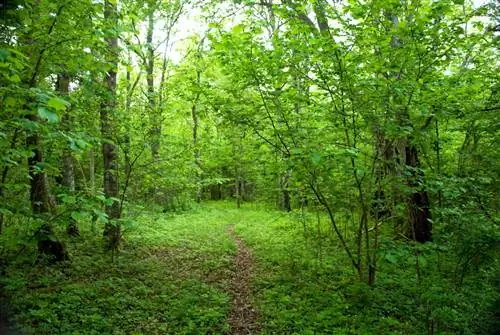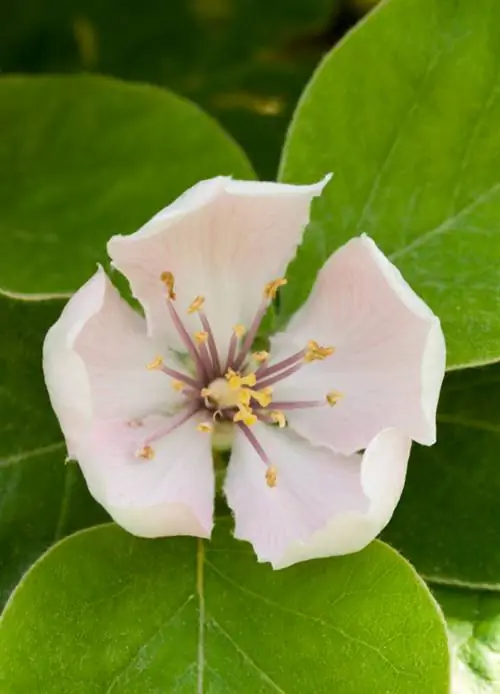- Author admin [email protected].
- Public 2023-12-16 16:46.
- Last modified 2025-06-01 06:02.
Concerned nature lovers scare away squirrels when they are black. They fear the maroon rodents are in danger. However, deterrent measures are not necessary because the black colored specimens only represent one color variant.
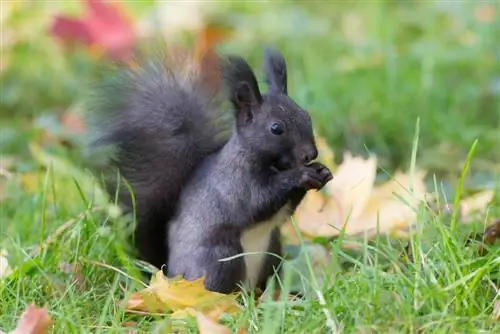
Are there really black squirrels?
Black squirrels are actually a color variant of the Eurasian squirrel (Sciurus vulgaris). They are more common at higher altitudes and during the winter months and are identified by their white belly. Their black coloring poses no threat to the reddish colored variant.
Are there black squirrels?
The Eurasian squirrel (Sciurus vulgaris) is native to Europe and is usually reddish in color. There are numerous color variations, ranging from reddish brown to reddish gray and brownish gray to black. Her distinctive white belly is distinctive.
The native squirrel can also be black. However, his belly is white.
In order for squirrels to survive the winter, they shed their fur in the fall. Their winter fur is shorter and thicker than their summer fur. It has a high proportion of gray so that the animals are better camouflaged from predators in the gray-white winter landscape. Such animals are often mistaken for gray squirrels, which are not native to Europe.
Black Squirrels - Origin
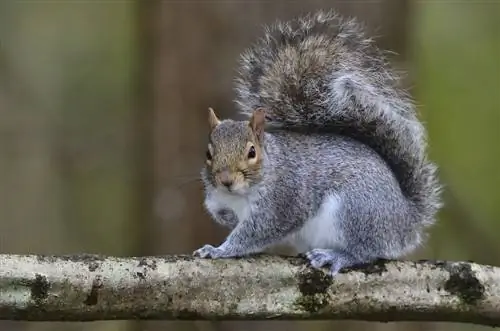
The American gray squirrel is also sometimes called the black squirrel
Behind the black squirrel there is not only a color variety of the native species. The American gray squirrel (Sciurus carolinensis) also has this misleading name. It is native to the USA and Canada. Humans have introduced the animal to Europe, where it is increasingly expanding in Great Britain, Ireland and Italy. In England, the Eurasian red squirrel is almost extinct due to high competition. The introduced species is currently missing from Germany. Experts suspect that it will also spread to Central Europe in the next few decades.
Background
Black squirrels displace red animals
The American tree squirrel proves to be particularly robust. It carries a pathogen that does not make the animals themselves sick. However, this pathogen can jump from the gray squirrel to the squirrel. This parapox virus (English: squirrelpox virus) is life-threatening for the native species and is causing squirrel populations to decline.
Meal plan of a gray squirrel:
- mainly seeds and buds
- preferred by beech, spruce, larch and birch
- also tree bark and mushrooms
- occasionally insects and frogs
- also young birds and eggs
Geographical barriers such as settlements, rivers or suboptimal landscapes do not represent an obstacle to the migration of gray squirrels. In the Central European deciduous and mixed forests they have a clear advantage over squirrels, because they actually depend on coniferous forests.
Dealing with gray squirrels
Sciurus carolinensis is on the European list of unwanted species, while Sciurus vulgaris is classified as not at risk. In England the gray squirrel population is estimated at 2.5 million. Various measures are being taken to protect the native species:
- Catch and shoot gray squirrels
- Call for private individuals to report gray squirrel sightings
- Informing the population about the problems
- Reminder to remove feeding places for squirrels and birds

Distinguish between squirrels and gray squirrels
The species introduced from America is usually uniformly colored. Color variations or slightly different nuances rarely occur. They reach a height of 30 centimeters. The tail is up to 20 centimeters long. Gray squirrels weigh between 400 and 700 grams. They have a significantly longer life expectancy than the native species. Sciurus carolinensis can live ten to twelve years. In comparison, it is twice as large and does not move as quickly as its European relative.
| Gray Squirrel | Squirrel | |
|---|---|---|
| Ears | no brush ears | typical tufts of hair at the tips of the ears |
| Belly | indistinctly colored white | purely white in color, sharply demarcated |
| typical fur coloring | gray to ochre | chestnut brown to reddish brown |
| Color Variations | light silver gray, dark black gray, very rarely reddish | Red brown, red gray, brown gray, black |
| Tail | with white edges | without white borders |
| Physique | plump, shorter neck, prominent skull | petite, longer neck, narrow skull |
Lifestyle of gray squirrels
These tree squirrels are omnivores that are not picky about their food. When food is scarce, cannibalism can occur. It lives in the forest and finds protection from predators in the undergrowth. Compared to the squirrel, the gray squirrel stays on the ground much more often. It does not go into hibernation, but feeds on its own food reserves during the cold season.
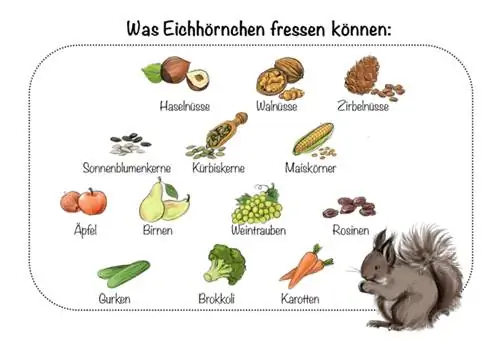
Excursus
The problem-solving ability of gray squirrels
Gray squirrels seem to use better tactics than squirrels when searching for food. English squirrel experts discovered this in an experiment. It could be a reason why the introduced species benefits from a survival advantage and prevails against the competition.
Results of the investigation
- Gray squirrels made several short attempts
- Squirrels spent a long time on one experiment
- Gray squirrels used different tactics than squirrels
While both species mastered a simple experimental setup equally well, more squirrels failed in the subsequent complex task. Around 90 percent of gray squirrels were able to solve the problem, while only about 70 percent of squirrels were successful.
Similar reproduction between both species
Grey squirrels and squirrels produce two litters per year, and three if weather conditions are favorable. The American representatives have no fixed mating times. However, young animals between September and December are unusual. A female can give birth to up to seven young per litter after around 45 days.
In the first few weeks, the naked and blind creatures have to be suckled every three to four hours. They leave the nest for the first time after seven weeks. At the age of ten weeks they are weaned from their mother and only eat solid food. They leave their mother after a month.
How to support squirrels
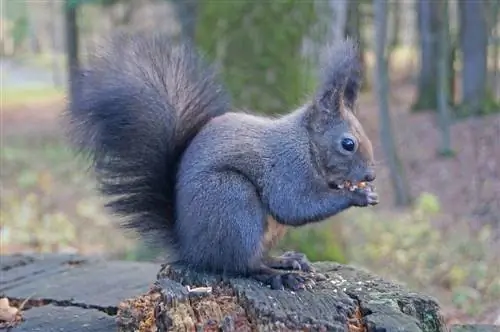
Squirrels can be supported with food, especially in winter
At the moment, the local tree squirrels do not have to fear competition from the American gray squirrel. If you see a black squirrel in winter, you should not drive it away but encourage it. It is looking for food to survive the winter.
Tip
Pregnant squirrels have a particularly high food requirement. Since the gestation period begins in January, you should offer food at the end of the year.
Offering food
The animals rely on high-energy food in winter. Provide the squirrels with a feeding area. Hazelnuts and walnuts are ideal. Sunflower and pumpkin seeds are also accepted, as are dried corn kernels and pine nuts. Chestnuts are a delicacy with a short shelf life. Therefore they should not be offered permanently.
Supplementary food:
- local fruits such as apples and pears
- Vegetables such as cucumbers, broccoli and carrots
- Grapes or raisins
Tip
Avoid exotic fruits, as they have a particularly long transport route.
Frequently asked questions
Can red and black squirrels exist at the same time?
When it comes to color variations of the domestic squirrel, different colored animals can live in one region at the same time. They are not in competition with each other because the fur color is comparable to human hair color. Mammal researchers found that the proportion of black squirrels is greater in higher mountain areas such as the Black Forest or the Alps in Bavaria than in the lowlands. However, dark and light colored squirrels can also occur in the same litter.
Possible reasons for geographical distribution:
- greater humidity due to higher amounts of precipitation
- cooler temperatures or larger temperature differences
- special food at high altitudes
- hereditary factors
In which forests are squirrels found?

Pine trees must be up to 40 years old before they bear fruit
The mammals depend on forests with a certain minimum age. This claim is based on food. Squirrels are predominantly seed eaters and collect cones and fruits from deciduous and coniferous trees. It takes a few years for the trees to produce enough fruit. Therefore, squirrels rely on old trees.
- Pine: first cone production after 30 to 40 years
- Spruce: forms cones after 50 to 60 years
- Beech: bears fruit for the first time after 50 to 80 years
Why are there so many black squirrels in some years?
Fruit and seed production varies from year to year. As a rule, every four years there is a so-called mast year in which excessive numbers of tree seeds are formed. This year the squirrel population is also increasing massively, so that suddenly many more black squirrels can appear in higher altitudes.
Can gray squirrels transmit diseases?
The American species carries the parapox virus. It is a pox virus that does not cause any symptoms in gray squirrels. By using the same nests at different times, it can spread to the Eurasian squirrel and cause the so-called squirrel pox. The animals suffer from weight loss because they eat less food. An infection shortly before winter can be fatal.
How do gray squirrels spread in Italy and England?
Large populations of pine martens have been identified in England in recent years. It is believed that the heavier and less agile gray squirrels fall prey to these mammals more quickly than the European specimens. Irish studies suggest that expanded pine marten populations could counteract the displacement of the Eurasian red squirrel.
Starting from Italy, some gray squirrels have spread to the Swiss border. There are observations of both species coexisting here. So far they have not displaced the native animals because they do not find optimal living conditions in the local coniferous forests.


